Meet Our Trainees
The Clinician Investigator Training Program draws residents and fellows from across the U.S. and around the world. Meet our current trainees and learn about their focus and research interests.
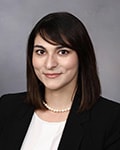 |
Aida Sarcon, M.D.Hometown: Irvine, California Undergraduate school: University of California, Berkeley Medical school: St. George's University School of Medicine Subspecialty: General surgery |
Principle investigators: Steven Moran, M.D. and Chunfeng Zhao, M.D. Research project/interests: Chest wall reconstruction, ischemia-reperfusion injury in soft tissue surgery, application of exosomes in regenerative medicine Why Mayo? I knew I wanted to train in a program with like-minded individuals that share my passion for patient care, research, and medical education. Why a CI? I am interested in building a career as a surgeon-scientist. I wanted to pursue dedicated research time during my postgraduate training to fine-tune my basic science and clinical research skills. Favorite thing to do in Rochester: Rochester has a lot of trails! I love enjoying a nice walk outside/hiking on the trails. Hobbies: I am a self-taught artist. Realism is my favorite genre. I also dabble in medical illustrations! |
 |
Mason Webb, M.D., Ph.D.Hometown: Augusta, Georgia Undergraduate school: University of Georgia Medical school: Medical College of Georgia Subspecialty: Hematology/Oncology (neuro-oncology) |
Principle investigators: Richard Vile, Ph.D., Ugur Sener, M.D., Jian Campian, M.D., Ph.D., Sani Kizilbash, M.D., M.P.H. Research project/interests: Primary CNS tumors, oncolytic virotherapy, CAR T, translational research Why Mayo? The excellence of its medical training and the number of world-class experts making phenomenal strides in translational cancer research. Why a CI? I chose to become a clinician investigator because of my interest in translational research and its ability to improve the lives of innumerable patients that I otherwise would not be able to see in a lifetime. Favorite thing to do in Rochester: Biking the trails in summer. Hobbies: Fishing, cycling, cooking, and traveling. |
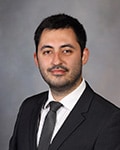 |
Ozan Dikilitas, M.D.Hometown: Istanbul, Turkiye Medical school: Acibadem Mehmet Ali Aydinlar University School of Medicine Subspecialty: Cardiology |
Principle investigator: Iftikhar Kullo, M.D. Research project/interests: My research focuses on elucidating genetic architecture of atherosclerotic cardiovascular diseases such as coronary heart disease as well as related traits such as lipids. I am very interested in leveraging findings and insights from genetic epidemiology studies into clinical risk prediction models/tools that can refine risk stratification of individuals and improve clinical care. Why Mayo? I have been inspired by my mentors and the physicians I have worked with during my time at Mayo Clinic as a visiting medical student and research fellow, and seen firsthand how the values of discipline, excellence, and collaboration are upheld with dedication to patient-centered care. Why a CI? I chose to become a clinician investigator to fulfill my passion for directly impacting patient care, while concurrently advancing the field of cardiovascular genomics. Envisioning the future, my ambition is to lead my own research program, bridging the gap between advances in cardiovascular genomics and their practical implementation in the clinical setting. Hobbies: Photography, programming, and learning to play the electric guitar. |
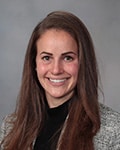 |
Whitney Thompson, M.D., M.PhilHometown: Rochester, Minnesota Undergraduate school: Cornell University Graduate school: University of Cambridge Medical school: University of Minnesota Subspecialty: Neonatology, medical genetics |
Principle investigator: Eric Klee, Ph.D. Research project/interests: My research is focused on implementation, improvement, and ethical analysis of rapid genome sequencing in the perinatal period. Why Mayo? Mayo truly puts the needs of the patient first. After interviewing here and learning about the Center for Individualized Medicine and the CITP, it was clear to me that this would be the place that would support my goals of completing training in pediatrics, neonatology, and medical genetics while developing a clinical neonatal rapid genome initiative with an integrated research program. Why a CI? The CITP provides a unique training opportunity with integrated clinical and research components that aligns with my long-term career objective to become a clinician scientist in the integrated diagnosis, management, and discovery of neonatal genetic diseases. The innovation of former and current CIs was evident, and I knew I wanted to learn and discover alongside this impressive group of clinician investigators. Hobbies: Peloton, running, and walking with my dog Ezra. |
 |
Jwan Naser, M.B.B.S.Hometown: Al Husun, Jordan Medical school: Jordan University of Science and Technology Subspecialty: Cardiology |
Research project/interests: I am most interested in valvular heart diseases, echocardiography, atrial fibrillation, and artificial intelligence. My research projects involve the application of artificial intelligence in ECG and echocardiography for screening and identification of diseases, characterization of functional mitral and tricuspid regurgitation, bioprosthetic valve failure, and the interaction between atrial fibrillation and other cardiac diseases. Why Mayo? When I was a medical student, I had the opportunity to come to Mayo for a visiting medical student clerkship in the cardiology consult service. I was impressed by the collegial culture where everyone on the team taught and learned from the other, regardless of hierarchy. I worked side-to-side with world-renowned experts who were down to earth and who set aside the time to teach residents and medical students. Even though my clerkship was only four weeks, I was offered research opportunities when I asked for them. I then spent a year doing research in the Echocardiography lab when I realized the great opportunities, mentorship, and resources that Mayo offers. Why a CI? I only started to do research in my last year in medical school, but this was enough time for me to realize how much I liked the process of hypothesis-generating based on clinical needs, turning the research question into a study design, and coming up with answers. I later spent a year doing research in the echocardiography lab, a field that fascinated me in medical school. During that time, I was able to confirm my interest in research, and my ultimate goal evolved to be a clinician scientist leading an established research laboratory with focus on advancing echocardiography. I chose the CI track because it offers dedicated time for research and formal mentorship tailored to my goals. In addition, as a major interest of mine has been augmenting disease diagnoses by applying artificial intelligence to conventional diagnostic tools, the CI track gave me the chance to pursue a master's degree in artificial intelligence. Favorite thing to do in Rochester: Grilling with friends outdoors in the beautiful nature of Rochester, biking, and kayaking. |
 |
Clifford Csizmar, M.D., Ph.D.Hometown: Sandpoint, Idaho Undergraduate school: Boise State University Medical school: University of Minnesota Subspecialty: Hematology and oncology |
Principle investigator: Scott Kaufmann, M.D., Ph.D. Research project/interests: My current research focuses on how myeloid cells repair DNA damage and respond to replication stress. For example, despite advances in targeted therapy, the cornerstone of treatment for acute myeloid leukemia (AML) remains either cytarabine plus an anthracycline or venetoclax plus a hypomethylating agent (HMA). Both anthracyclines and HMAs form DNA-protein crosslinks that induce replication stress, but why these agents are efficacious in AML remains unclear. Thus, our work aims to understand the replication stress response mechanisms in myeloid cells in order to design more effective treatment regimens for AML. Why Mayo? I chose Mayo Clinic for the world-class clinical training, robust research opportunities, and authentic collegiality. We are fortunate to treat patients from across the globe alongside expert clinicians who have led landmark trials and written clinical practice guidelines. Meanwhile, research endeavors span the basic sciences from national clinical trials to the integration of artificial intelligence into patient care. Perhaps most importantly, this is accomplished with a genuine sense of welcome and a culture of caring for each other. A low cost of living and a commute measured in minutes helps, too! Why a CI? The CITP allows for a unique integration of clinical and post-doctoral research training. By providing two years of fully funded and protected research time between residency and fellowship, I have the opportunity to develop and test hypotheses while preparing for the transition to independent practice. CI trainees have an outstanding track record of securing extramural faculty development awards, and Mayo Clinic is highly supportive of early career investigators. As someone who is passionate about patient care and basic science, the CITP was an excellent fit for me. Favorite thing to do in Rochester: Rochester itself is graced by endless running and cycling paths. However, there is no better way to take in the beauty of the Driftless Area than by biking along the endless ribbons of gravel roads surrounding town. There are numerous state parks within an hour's drive, and the North Shore of Lake Superior is not to be missed on a long weekend. Otherwise, there's always patio space to enjoy the unrivaled summer nights here in Minnesota. Hobbies: Gravel cycling, hiking, and enjoying the great outdoors with my wife, infant son, and two Boston terriers. |
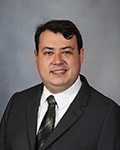 |
Rick Lindsey, M.D., Ph.D.Hometown: Torrance, California Undergraduate school: Biola University Medical school: Loma Linda University School of Medicine Subspecialty: Endocrinology |
Principle investigator: Sundeep Khosla, M.D. Research project/interests: Mechanisms of skeletal metabolism and cellular senescence Why Mayo? I chose Mayo Clinic for the combination of excellent clinical training and the opportunity to work with world-class faculty in my area of interest. Why a CI? The chance to have an extended period of dedicated research time without sacrificing the quality of my clinical training made the CI program seem like an ideal fit for my goals. Favorite thing to do in Rochester: Spend time with friends, try new restaurants, attend church, and explore Quarry Hill Park. Hobbies: Reading (widely and eclectically), coffee, podcasts, and technology. |
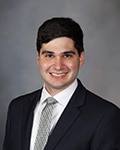 |
Alexander Ticho, M.D., Ph.D.Hometown: Wausau, Wisconsin Undergraduate school: St. Olaf College Medical school: University of Illinois at Chicago Subspecialty: Gastroenterology and hepatology |
Principle investigator: Andres Acosta, M.D., Ph.D. Research project/interests: Understanding the role of the intestine and gut hormones in the pathogenesis and treatment of obesity and obesity-associated diseases Why Mayo? I wanted to train at an institution that expects their researchers to also be outstanding clinicians and supports their physician-scientists so that they are able to excel in both arenas. Favorite thing to do in Rochester: Mountain biking at Gamehaven and visiting Quarry Hill Nature Center with my family. Hobbies: Biking, cooking, and gardening. |
 |
Fadi Adel, M.D.Hometown: Baghdad, Iraq Undergraduate school: The University of Texas at Austin Medical school: The University of Texas Long School of Medicine Subspecialty: Cardiovascular diseases |
Principle investigator: Horng Chen, M.D. Research project/interests: My primary focus has been on translational research in diabetic cardiomyopathy and cardiomyopathy associated with non-alcoholic fatty liver disease. Specifically, we are investigating the cardiorenal and metabolic profiles of such diseases in animal models and in humans. Furthermore, we are developing and testing novel natriuretic peptide therapeutics. Why Mayo? On my interview day, the trainees at Mayo stood out as smart, passionate, and patient-centered. Most importantly, as a clinician, I wanted to train at a premiere academic center where I could master the bread-and-butter of medicine in addition to being exposed to fascinating, rare cases. Furthermore, as a researcher, I was very impressed with the unparalleled support for meaningful, cutting-edge research during training. Why a CI? I have chosen to become a clinician-investigator because I envision my future career to include clinical work, translational research, and education. I realized that there is a significant gap between the findings in the basic sciences and our current bedside practice, and my goal is to bridge this gap in cardiovascular diseases. Favorite thing to do in Rochester: Relax and/or get work done at Cafe Steam or Spyhouse, explore the new restaurants, go hiking in Quarry Hill or Whitewater State Park, and, sometimes, go fishing (very much a novice). Hobbies: Cooking, traveling, reading non-fiction, hiking, visiting museums, swimming, exploring local coffee shops, advocacy, and hanging out with friends and family. |
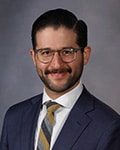 |
Saam Dilmaghani, M.D., M.P.H.Hometown: Oakton, Virginia Undergraduate school: University of Virginia Medical school: Georgetown University Subspecialty: Gastroenterology and hepatology |
Principle investigator: Michael Camilleri, M.D., D.Sc. Research project/interests: Disorders of gut-brain interaction, neurogastroenterology, clinical research methodology, big data, artificial intelligence Why Mayo? Without question, Mayo Clinic exemplifies research productivity, compassionate clinical care, and outstanding educational experiences. However, what struck me the most was the degree of enthusiastic collaboration and mentorship between faculty and staff of all years in training. I knew this environment would provide the best opportunity to lay the foundation for my future career. Why a CI? My involvement in the CITP is motivated by my curiosity, particularly to understand the misunderstood, which is very commonly seen among patients with disorders of gut-brain interaction. As a clinician-investigator, we are best positioned to determine the research questions that are likely to have the greatest clinical impact, and can oversee its translational from the bench to bedside. Favorite thing to do in Rochester: I enjoy trying out the newest restaurants and cafes, rock climbing, yoga, and walking in my neighborhood. Hobbies: Anything music, coffee, cooking, board games, and traveling (particularly to places where I don't speak the language). |